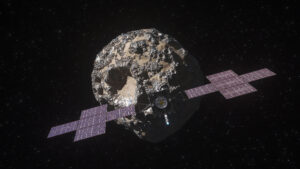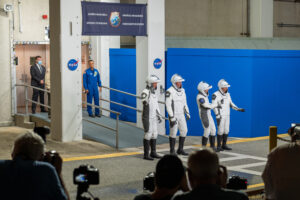With each mission to space, there is one more step forward on humanity's road to Mars.

From the Press Site lawn at Kennedy Space Center. A long exposure of Falcon 9 lifting off with Crew-6 and their Crew Dragon
The NASA/SpaceX Crew-6 mission launched on Thursday, March 2, 2023, from Launch Complex 39A at NASA’s Kennedy Space Center in Florida. Launching at 12:34 a.m. EST, it would dock to the International Space Station (ISS) on Friday, March 3, at 1:40 a.m. EST. Expedition 69 at the International Space Station begins and Cosmic Perspective’s John Pisani was on the ground to witness and capture the launch at Kennedy Space Center.
This expedition will include research investigations focused on biology, Earth science, human research, physical sciences and technology development, providing the foundation for continuing human spaceflight beyond Low-Earth Orbit to the Moon and Mars.
This sixth crew rotation mission, provided by SpaceX, is part of the agency’s Commercial Crew Program. The four crew members not only represent humanity, but also the respected countries they call home. Through the Commercial Crew Program, and on Crew-6, countries like the United Arab Emirates (UAE) can send some of their first astronauts to the ISS.
- Mission Commander Stephen Bowen – NASA
- Pilot Warren Hoburg – NASA
- Flight Engineer Sultan Alneyadi – UAE
- Flight Engineer Andrey Fedyaev – Roscosmos

Credit: John Pisani for Cosmic Perspective
Bowen is a veteran of three Space Shuttle missions, while Hoburg is making his first spaceflight. Alneyadi is one of the first astronauts from the United Arab Emirates to fly to the ISS. Fedyaev rounds out the crew and is a veteran of two Soyuz missions. The crew will spend approximately six months on the ISS, conducting a variety of science experiments and maintenance tasks. The mission will also include a spacewalk to install new solar arrays on the Space Station.
This mission is a major milestone for the Commercial Crew Program, which has successfully launched six crewed missions to the ISS since 2020. The program has helped to make spaceflight more affordable and reliable, and it has paved the way for future missions to the Moon and Mars, while simultaneously supporting our continued access and presence in Low Earth Orbit.
Video from near the countdown clock. Incredible audio with the nine Merlin 1D engines crackling and echoing around the press site.
Crew-6 plays a critical role in the ongoing operations of the International Space Station. The ISS is a complex, multi-national scientific laboratory that requires constant maintenance and upkeep. Crewmembers will be responsible for a variety of tasks, including:
- Conducting scientific experiments
- Maintaining the ISS’s systems and equipment
- Performing spacewalks
- Providing support to the other crew members on the ISS
NASA’s Commercial Crew program and SpaceX’s contributions to it have allowed many nations an opportunity to contribute to the ISS. This mission marks a trip for one of the first astronauts from the United Arab Emirates to participate in the exploration of space. Alneyadi’s presence on the crew is a symbol of the UAE’s commitment to space exploration.
I am regularly humbled by the continued pace at which spaceflight has rapidly increased. It’s one thing to capture and document the ordinary, but it’s really something else to capture history in the making. Humanity is going back to the Moon and then on to Mars in an epic quest to explore the vastness of space and learn to live and work on our terrestrial neighbors. However, in doing so, it will become ordinary. And while I stand there with my cameras at the press site, causeway, or just somewhere around, watching launches on the Space Coast will never get old.


Falcon 9 and Crew Dragon Endeavour clearing the tower at 39A



